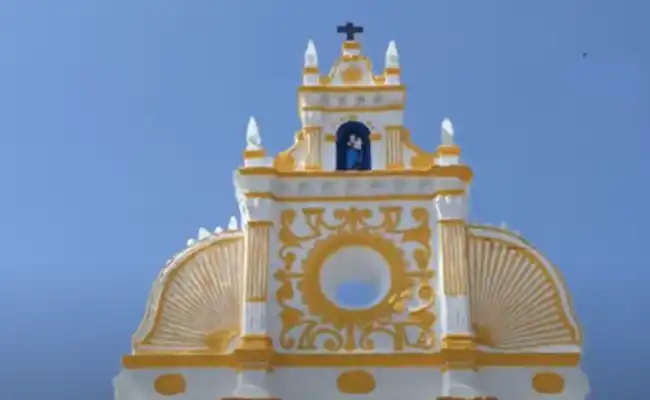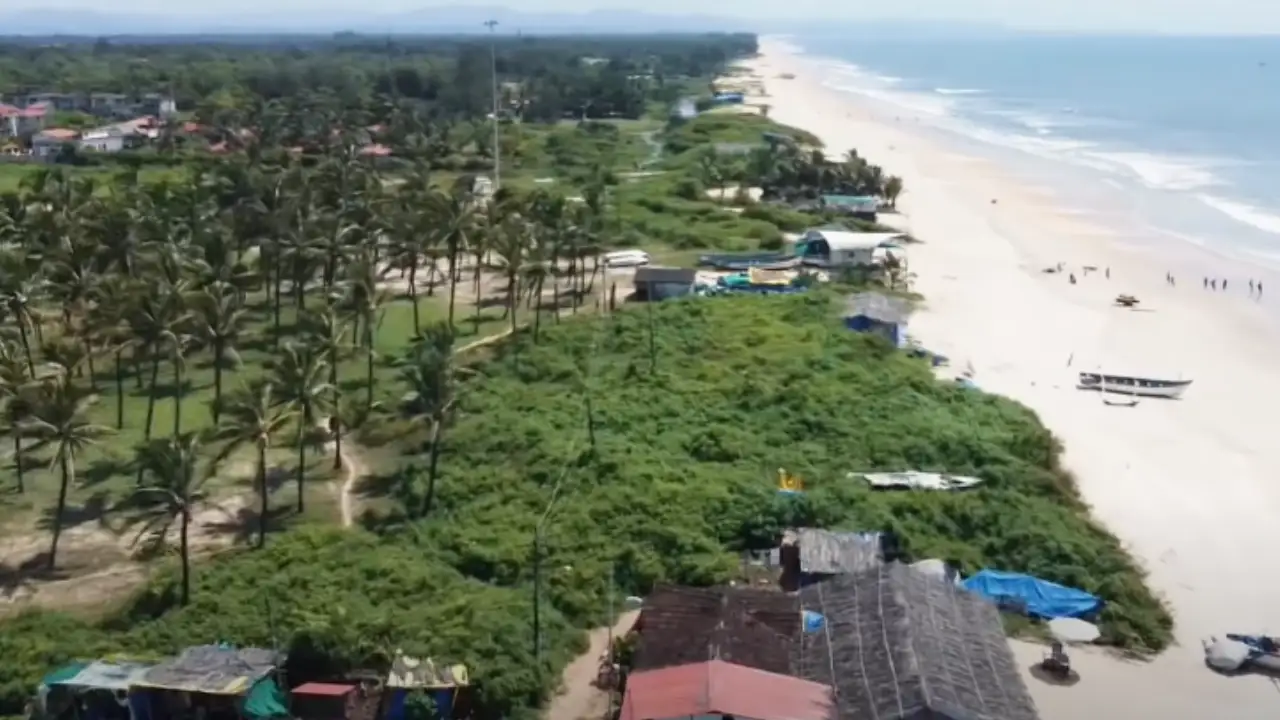
Sancoale Goa | Our Lady of Health Church | Remains Of Church
Sancoale Goa is located near Vasco da Gama. Just before entering the city, you’ll come across Our Lady of Health Church, which houses the remains of the Sancoale Church. It is an Archaeological place.
Evidently, the church met its demise in the 18th century. Situated close to the Zuari River in Sancoale, what remains today is a testament to what must have been a grand and magnificent structure. Historical records indicate that the church was destoryed in the 1800s. Despite this tragic event, the existing ruins serve as compelling evidence of the once beautiful architectural marvel that stood in this location.
This article delves into the history of the church, exploring its destruction, its earlier existence, and the political issues surrounding it.
Sancoale Goa | History of Sancoale Church Goa | Remains Of Sancoale Church
Built by Jesuit missionaries who arrived in Sancoale in 1560, the Igreja de Nossa Senhora de Saúde, known as Our Lady of Health Church or the Old Church of Sancoale, stands as a testament to their arrival and settlement there. To commemorate their presence, they established the Chapel of Nossa Senhora de Saúde, a dedication to Our Lady of Health.
In contrast to the renowned facade of the 16th-century Sancoale church, which has achieved iconic status, another piece of heritage with equally charming architectural features remains relatively unknown in Chimbel. The Sancoale facade, standing tall along the Zuari River, is the remains of the Our Lady of Health Church, which fell victim to a fire in 1834. Today, this preserved section of the original structure, constructed in 1566, captures the attention of locals, tourists, and pilgrims, attracting visitors even from as far away as Sri Lanka.
In the late 1500s, the Jesuits secured a decree from the Portuguese viceroy allowing them to use part of the revenues from Salcete villages for catechumens. These converts, including bhatkars, were encouraged to embrace Catholicism, replacing numerous family shrines with a Jesuit-consecrated church.
Sancoale Goa – Watch The Video For More Details
Deterioration Over Decades: The Fate of the Church and Structures
According to researchers, the church and other structures at the site began to deteriorate after the mid-1920s. By the 1990s, the facade also started crumbling. “Although it was a fascinating site, our sincere efforts were unable to preserve the church,” remarks Conception.
Jesuit Influence and Church Establishment in Sancoale: 16th to 17th Century
Portuguese colonization aimed to “save the souls” of the local people, as per Pope Alexander VI’s 1493 decree. Afonso de Albuquerque conquered Old Goa in 1510 but permitted sects to practice their ancient faith.
The Jesuits built Sancoale’s Nossa Senhora de Saude chapel in 1566 due to plagues. Gaonkar-brahmin converts constructed their church in 1606, evidenced by tombstones of Cunha, Menezes, and Cardoso. No record of pre-existing temples exists, according to Jesuit historians.
The church, struck by lightning, remains a tourist attraction. In 1834, a fire led to the elevation of Anaulim’s chapel as the new Church of Sancoale.
The ‘Fabrica of Church of Sancoale’ has owned the property for 400+ years, declared a ‘Protected Monument’ by the Goa government. St. Joseph Vaz’s 1677 “Deed of Bondage” links the church to Mother Mary.
The road to the old church ruins was named “Rua do Escravo de Maria” (Road of Bondage of Mary). In 1937, the Portuguese Government declared the church facade a national monument. The Sancoale church unquestionably owns its land, dating back to 1606 or possibly 1560. The Archaeology Department preserves the monument but does not own the land.

Restoration Efforts for Formerly Celebrated Holy Mass at Chimbel Church
Holy Mass used to be celebrated at this church until a few decades ago. We reached out to various authorities, particularly the Provedoria, which manages the old age home, to initiate restoration,” states Lourdes Conception, a senior resident of Chimbel.
Sacred Gathering | Novenas and Feast of Saint Joseph Vaz | Our Lady Of Health Church Sancoale
Now adorned with gardens and benches, this place serves as a venue for conducting novenas and the feast of the native patron, Saint Joseph Vaz. Pilgrims from across the state flock to the location to pay their respects, creating a lively atmosphere. The feast of Blessed Joseph Vaz is an annual celebration, drawing people from far and wide who come seeking blessings.
A Journey Through Crumbling Stones | A solitary figure standing amidst the ruins
Immerse yourself in a forgotten realm: Explore the ruins of a hidden church, where history whispers through crumbling walls and solitude reigns supreme. Ample parking. No crowds, just whispers of faith in crumbling walls
Sancoale Church Issue | Our Lady Of Health Church Sancoale
A storm brews in Goa, where the separation of politics and religion is fiercely debated. The flashpoint: the 416-year-old Sancoale church. Whispers circulate, fueled by fringe elements, that it’s actually a Laxmi Narasimha temple usurped centuries ago. Could this claim be a Trojan horse, paving the way for similar “reclaiming” of churches with alleged temple foundations?
Since 1606, Our Lady of Health has stood unchallenged on the land, save for a recent tenancy dispute over seven church properties. Whispers of a hidden temple fuel the litigant’s argument, hinging on the curious right to pluck coconuts.
Tensions peaked with a December 30th puja and an inflammatory January 2nd speech, aimed at disrupting the church’s January 16th feast. Thankfully, violence was averted. Still, fears linger of land grabs fueled by historical amnesia. But documents speak volumes: Form I and XIV stand as testaments to the rightful ownership under the Fabrica de Igreja de Nossa Senhora de Saude. Can truth rise above the din of whispers and claims? Time will tell.

Sancoale Church Recent Issue | Subhash Velingkar
Subhash is threatening to initiate a statewide agitation if the government does not return the temple land to Hindus. According to him, the church took control of an area where a temple once stood, and it was destroyed by the Portuguese during their regime. Subhash insists that the land should be restored to Hindus for the reconstruction of the temple.
The remnants of the Hindu temple were visible until 2012, but the church, utilizing heavy machinery, removed all traces. He further claims that the church filled a pond and uprooted a massive banyan tree from the site. Subhash demands a complete excavation of the entire area.
Sancoale Goa – Conclusion:
The Sancoale Church stands at the crossroads of history, politics, and religious identity in Goa. From the remnants of a 16th-century structure to recent disputes over its origins, the narrative weaves through time, echoing both cultural heritage and contemporary challenges. The silent ruins, once a thriving place of worship, now witness debates over ownership and narratives of historical preservation.
As the whispers of the past clash with present claims, the church remains a symbol of enduring complexities. In this delicate balance between heritage and disputes, the Sancoale Church signifies not just a physical structure but a living testament to Goa’s intricate history.

Sancoale Goa – FAQs
1. What is the historical significance of Sancoale Church in Goa?
The Sancoale Church, also known as Our Lady of Health Church, holds historical importance as it dates back to the 16th century. Built by Jesuit missionaries, it stands as a testament to the early presence of Catholicism in the region.
2. When did the Sancoale Church face its demise, and what led to its destruction?
The Sancoale Church met its demise in the 18th century, and historical records suggest that it was destroyed in the 1800s. The exact cause of its destruction remains a subject of exploration.
3. Who were the Jesuits, and what role did they play in the establishment of Sancoale Church?
Jesuits were missionaries who arrived in Sancoale in 1560. They played a crucial role in building the Igreja de Nossa Senhora de Saúde (Our Lady of Health Church) as a dedication to Our Lady of Health.
4. What architectural features make the Sancoale Church notable?
The Sancoale Church, with its renowned facade and charming architectural features, stands tall along the Zuari River. It is a preserved section of the original structure constructed in 1566.
5. Why did the church face deterioration over the decades, and what restoration efforts were made?
According to researchers, the church and its structures started deteriorating after the mid-1920s. Despite sincere efforts, restoration attempts were unsuccessful, leading to the crumbling of the facade by the 1990s.
Suggested Articles:
St. Cajetan Church – Old Goa | One of the Famous Church’s in Goa
The Mystery Of Three Kings Church – Goamygoa
Se Cathedral | Se Cathedral Church – Old Goa
Chapel Our Lady of the Mount | Monte Hill Church Old Goa

